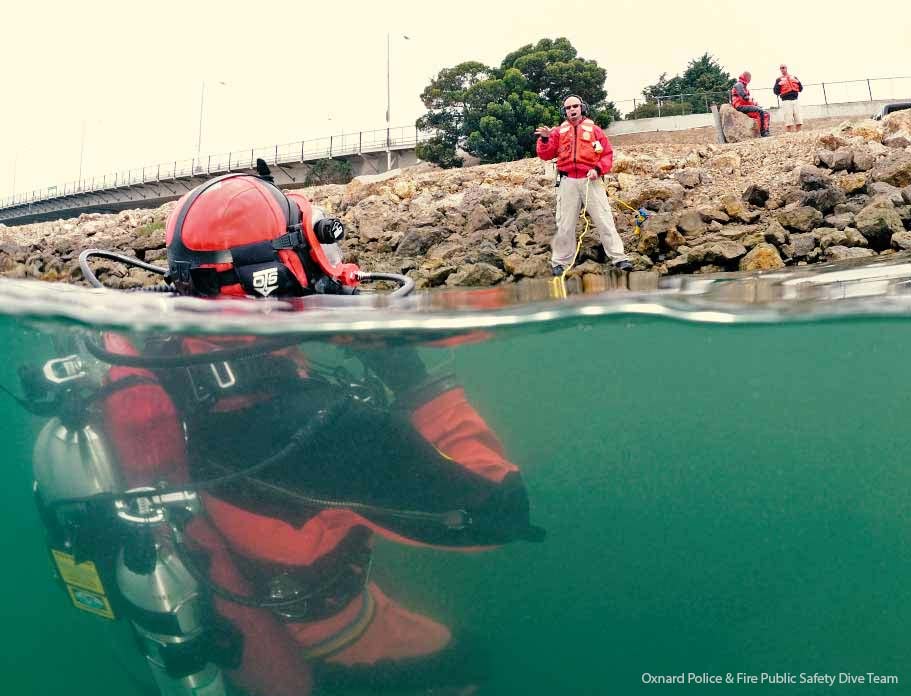Take Your Tech Diving Skills to the Public Safety Sector
by Dr. Thomas Powell:
Scuba diving is a sport in which a person can always grow and learn. Anyone who has looked at the list of available classes out there can understand that the sky is the limit when it comes to scuba education. Similarly, there exist multiple types of diving around which a diver can focus education, skill progression, and experience. The reality of the various educational pathways is that they all have the potential to build upon one another.
Public Safety Diving is a type of diving based upon the training divers receive along a pathway. First, public safety divers are trained as open water scuba divers. From that point, they may venture directly into the public safety realm or move on to learn more about technical or recreational skill sets. Like any other subject, increased education and experience often leads toward an improved level of overall performance. Essentially, the more a diver gets wet, and the more that diver tries to learn, the better he or she may have the potential to become as a public safety diver.
Public safety diving is one of the most dangerous realms within scuba diving. Divers often enter the water not knowing bottom terrain, currents may be present, and the visibility may be nil. Similarly, the technical diving realm is one in which divers work to better understand physiology, gas switches, safety precautions, and bailout procedures. Many of these activities are practiced without a mask while maintaining neutral buoyancy. Each of these subjects has a direct correlation to public safety diving. Imagine that a diver is in zero visibility, stuck in an entanglement hazard, and low on air. Technical training can better prepare that public safety diver to handle gas switches and emergency procedures while blind.
Similarly, technical divers tend to focus on streamlining equipment, exposure protection, moving items for convenient placement, neutral buoyancy, launching buoys and bags, and equipment redundancy. Again, each of these actions can also be found within public safety diving. First, public safety divers often carry lots of equipment and wear bulky garments. This equipment must be streamlined to prevent entanglement issues and moved around as needed for easy access in zero visibility. Second, public safety divers often spend time on the bottom doing hand searches for missing items. The problem with settling on the bottom is that the diver may accidentally move, cover, bury, or miss an item. The diver may also further “muck up” the environment for secondary searches. Finally, public safety divers often carry lots of redundant items for safety. Many of these items may be marker buoys or even lift bags.
Technical training may be a perfect baseline for any public safety diver. Technical training can teach a diver to perform tasks while close to the bottom but maintaining neutral buoyancy, and move excess items around on the body in a fashion that helps streamline equipment and reduce the effect on diver trim. Essentially, technical training may allow a public safety diver to better understand how to carry equipment, use equipment, reduce any effect on bottom terrain, and avoid the development of foreseeable problems. Every Technical Diving International class also teaches divers to launch buoys and bags. Every public safety diver must be proficient at launching marker buoys and working with lift bags. Again, this is technical training that can help any public safety diver become more proficient at his or her trade.
In regard to overhead environments, technical training may also include cave training. Cave training teaches divers how to be safe and proficient in overhead environments when visibility may change in a quick fashion. Cave divers learn to lay lines that can be followed back to an exit while working in a confined space and as a team. Again, each of these actions is something valuable to a public safety diver. Almost any environment may be considered an overhead environment for a public safety diver. If the diver cannot see, he or she may not know what is overhead or if there is an obstruction between the diver and the surface. Training to lay lines and understand how to properly backtrack can help a public safety diver remain safe in an unknown environment. Similarly, a proper education on laying lines can help a diver or dive team return to a known location in an efficient fashion, mark specific positions, and do so while maintaining a tight continuous line with minimal extraneous hazard developments. Finally, cave divers are trained to deal with tight spaces. Imagine a public safety diver entering a wrecked school bus in an effort to perform a recovery. That diver must be able to act and react in a proficient fashion with minimal space to move. This is something that cave classes teach.
Technical training is something that can help any public safety diver become more proficient at necessary skill sets. The current problem is that many public safety divers begin public safety training and do not have the personal time or resources to take on technical programs. As excess or secondary training opportunities, technical classes should be considered by public safety dive teams to help provide growth and development opportunities for divers. Education and time in the water is something that can help any diver. The first big step is to inquire about training opportunities and to decide for yourself how it can help you or your team.
– Dr. Thomas Powell
Owner/Instructor Trainer – Air Hogs Scuba, Garner, NC


返信を残す
Want to join the discussion?Feel free to contribute!